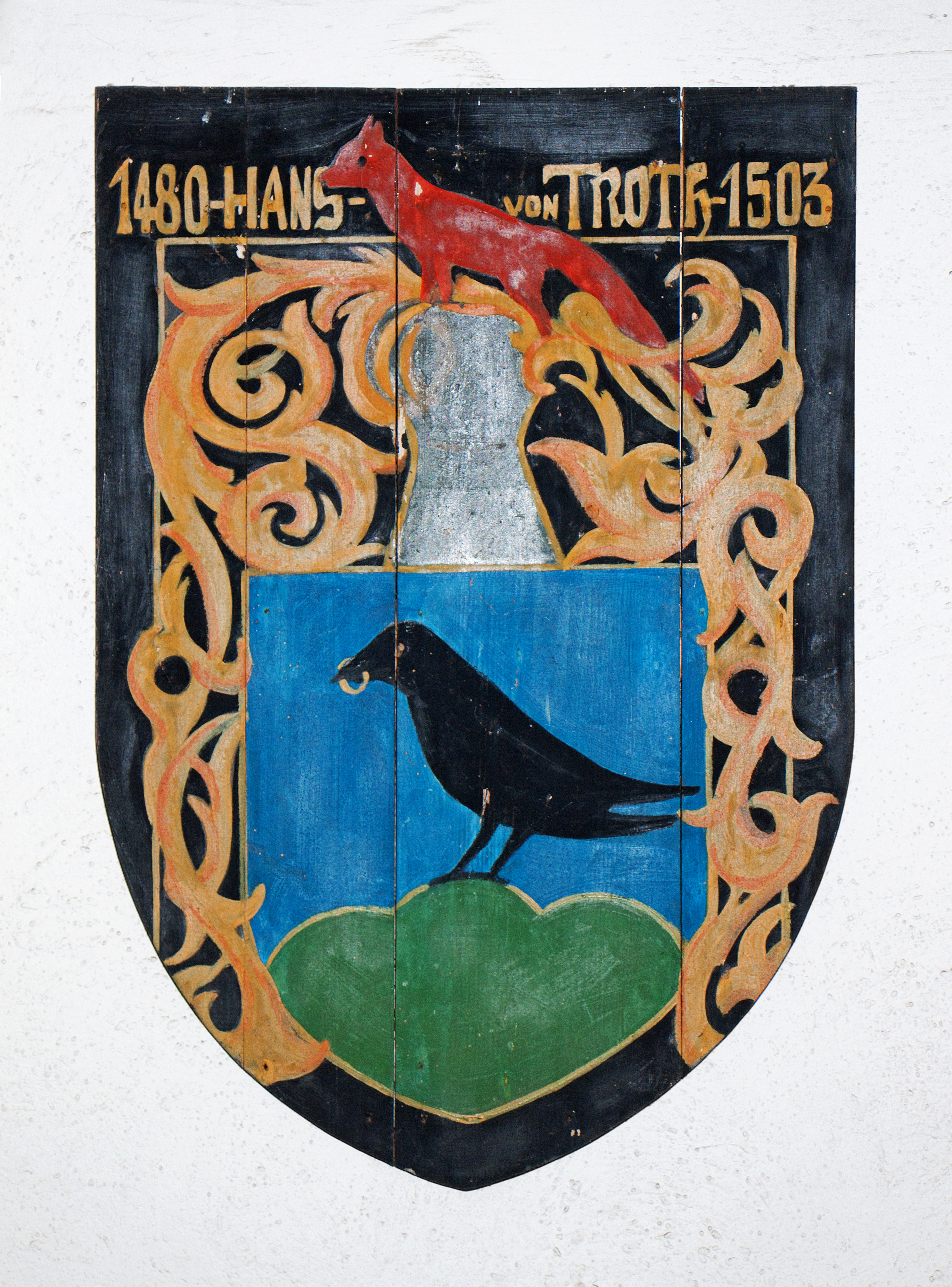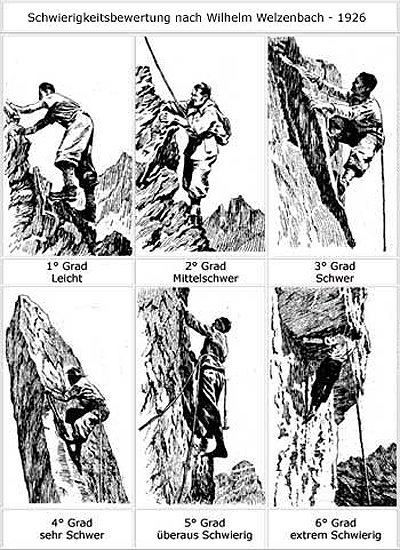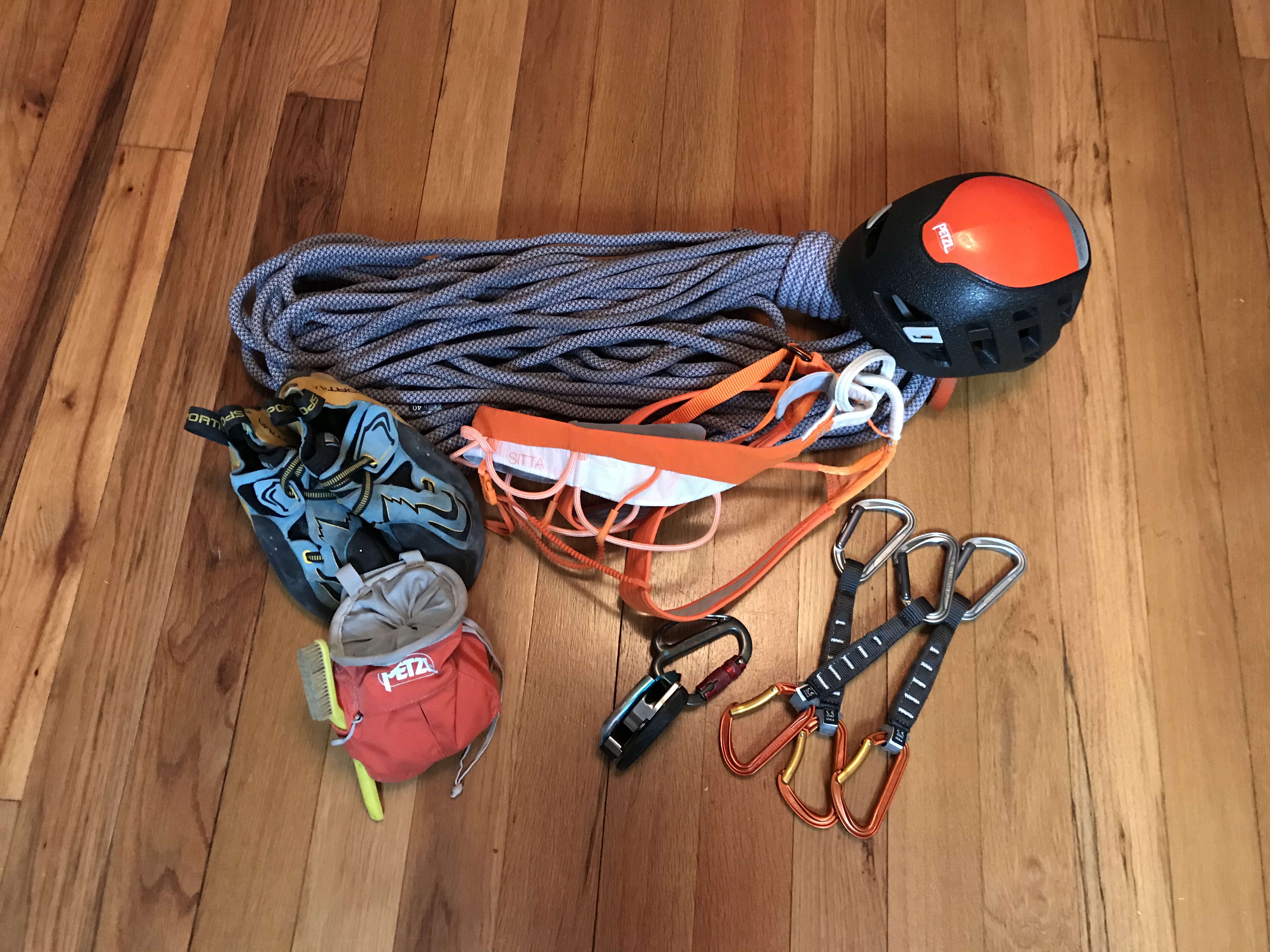|
Jungfernsprung
The Jungfernsprung, is a precipitous rock formation in the small German town of Dahn in the county of Südwestpfalz. The rocks tower above the town by around 70 metres and are crowned by a type of summit cross at a height of . The rocks is the symbol of the town and the subject of an ancient legend from which it derives its name: Jungfernsprung means "maiden's leap". Location and structure The Jungfernsprung lies in the eastern part of the borough. Its west and north faces rise, steep and ruggedly, from the slopes on the left-hand side of the Wieslauter valley, whilst the residential area of Dahn spreads out southwest of the rocks on both sides of its base. The rocks belong to the many bunter sandstone formations, typical of the Wasgau region, the southern part of the Palatine Forest in Germany and the northern part of the Vosges in France. Because the area around Dahn is especially rich in such rock features it is also called the Dahner Felsenland ("Dahn Rock Country"). ... [...More Info...] [...Related Items...] OR: [Wikipedia] [Google] [Baidu] |
Dahner Felsenland
The Dahner Felsenland, also referred to as the Dahn Rockland, is a landscape in the county of Südwestpfalz in the German federal state of Rhineland-Palatinate. It is located in the middle section of the Wasgau, which in turn forms the southern part of the Palatine Forest and the northern part of the Vosges in France. The Dahner Felsenland has numerous rock formations within the South Palatinate Climbing Area (''Klettergebiet Südpfalz''). Geographic location The landscape covers almost the same area as the collective municipality of the same name, which incorporates the town of Dahn and 14 villages. The Dahner Felsenland is part of the Palatine Forest Nature Park. It lies between 200 m (valleys) and 400 m (hilltops) high and is drained by the Lauter, which here in its upper reaches is called the ''Wieslauter'', into the River Rhine. Tourism The region has been opened up by a large number of waymarked walking routes. In Dahn itself is the Felsenland Youth ... [...More Info...] [...Related Items...] OR: [Wikipedia] [Google] [Baidu] |
Hans Von Trotha
Hans von Trotha also known as Hans Trapp (c. 1450 – 1503) was a German knight and marshal of the prince-elector of the Palatinate. He also bore the French honorary title of a ''Chevalier d’Or''. In 1480, the elector enfeoffed him with the two castles of Berwartstein and Grafendahn which lay in the South Palatine part of the Wasgau region within the Palatinate Forest. In local folklore he is known as Hans Trapp or, more rarely, Hans Trott. Family Hans von Trotha was born into the aristocratic Trotha family who came from the area of the present-day county of Saalekreis, and was the fourth son of the Archbishop of Magdeburg's marshal, Thilo von Trotha. He was probably born in the mid-15th century in Krosigk (today in Saxony-Anhalt). His exact date of birth is not known, but he was the younger brother of Thilo von Trotha, the Bishop of Merseburg who was born in 1443. Hans only had one son, Christoph, who succeeded his father as the lord of Berwartstein Castle. Because Chri ... [...More Info...] [...Related Items...] OR: [Wikipedia] [Google] [Baidu] |
Dahn
Dahn is a municipality in the Südwestpfalz district, in Rhineland-Palatinate, Germany. It is situated in the Palatinate Forest, approximately 15 km southeast of Pirmasens, and 25 km west of Landau. It is part of the ''Verbandsgemeinde'' ("collective municipality") of Dahner Felsenland. Geography Dahn is located 210 m above sea level in a valley of the Dahner Felsenland, a part of the Wasgau, which is itself a part of the Palatinate Forest. A small creek, the Lauter, flows through Dahn, and here, in the area of its headwaters, is called the ''Wieslauter''. The border with Alsace (France) is located 10 km south of Dahn. History Coat of arms In 1952 the coat of arms was recreated as a result of historical research. The new shield, parted per chevron, has on its dexter chief: azure (blue), a cross argent (silver); on its sinister chief: gules (red), an eagle argent (silver) and on its base: or (gold), a fir tree vert (green). The fir tree (german: Tanne, ssu ... [...More Info...] [...Related Items...] OR: [Wikipedia] [Google] [Baidu] |
Wasgau
The Wasgau (german: Wasgau, french: Vasgovie) is a Franco-German hill range in the German state of Rhineland-Palatinate and the French departments of Bas-Rhin and Moselle. It is formed from the southern part of the Palatine Forest and the northern part of the Vosges mountains, and extends from the River Queich in the north over the French border to the Col de Saverne in the south. The highest hill in the entire Wasgau is the Grand Wintersberg (581 m above NHN) near Niederbronn-les-Bains in northern Alsace. Next, at 577 m is the only slightly lower Rehberg near Annweiler in the South Palatinate, which is the highest summit on German soil in the Wasgau. The Wasgau forms the southern part of the Palatine Forest-North Vosges Biosphere Reserve. Geography Location The Wasgau runs from a line between Pirmasens and Landau in the north that, from Wilgartswiesen coincides with the course of the River Queich, to the Col de Saverne and a line between Phalsbourg to Sa ... [...More Info...] [...Related Items...] OR: [Wikipedia] [Google] [Baidu] |
Hiking Trail
A trail, also known as a path or track, is an unpaved lane or small road usually passing through a natural area. In the United Kingdom and the Republic of Ireland, a path or footpath is the preferred term for a pedestrian or hiking trail. The term is also applied in North America to routes along rivers, and sometimes to highways. In the US, the term was historically used for a route into or through wild territory used by explorers and migrants (e.g. the Oregon Trail). In the United States, "trace" is a synonym for trail, as in Natchez Trace. Some trails are dedicated only for walking, cycling, horse riding, snowshoeing or cross-country skiing, but not more than one use; others, as in the case of a bridleway in the UK, are multi-use and can be used by walkers, cyclists and equestrians alike. There are also unpaved trails used by dirt bikes and other off-road vehicles, and in some places, like the Alps, trails are used for moving cattle and other livestock. Usage In Australia ... [...More Info...] [...Related Items...] OR: [Wikipedia] [Google] [Baidu] |
Innocence
Innocence is a lack of guilt, with respect to any kind of crime, or wrongdoing. In a legal context, innocence is to the lack of legal guilt of an individual, with respect to a crime. In other contexts, it is a lack of experience. In relation to knowledge Innocence can imply lesser experience in either a relative view to social peers, or by an absolute comparison to a more common normative scale. In contrast to ''ignorance'', it is generally viewed as a positive term, connoting an optimistic view of the world, in particular one where the lack of knowledge stems from a lack of wrongdoing, whereas greater knowledge comes from doing wrong. Subjects such as crime and sexuality may be especially considered. This connotation may be connected with a popular false etymology explaining "innocent" as meaning "not knowing" (Latin ''noscere'' (To know, learn)). The actual etymology is from general negation prefix ''in-'' and the Latin ''nocere'', "to harm". People who lack the mental cap ... [...More Info...] [...Related Items...] OR: [Wikipedia] [Google] [Baidu] |
Climbing Areas Of Germany
Climbing is the activity of using one's hands, feet, or any other part of the body to ascend a steep topographical object that can range from the world's tallest mountains (e.g. the eight thousanders), to small boulders. Climbing is done for locomotion, sporting recreation, and for competition, and is also done in trades that rely on ascension; such as emergency rescue and military operations. Climbing is done indoors and outdoors and on natural (e.g. rock and ice) and artificial surfaces. Professional mountain guides or rock climbing guides (e.g. the UIAGM), were a significant element in developing the popularity of the sport in the natural environment, and remain so today. Since the 1980s, the development of competition climbing and the availability of artificial climbing walls have dramatically increased the popularity of rock climbing as a sport and led to the emergence of professional rock climbers, such as Wolfgang Güllich, Chris Sharma, Lynn Hill and Catherine ... [...More Info...] [...Related Items...] OR: [Wikipedia] [Google] [Baidu] |
Rock Formations Of Rhineland-Palatinate
Rock most often refers to: * Rock (geology), a naturally occurring solid aggregate of minerals or mineraloids * Rock music, a genre of popular music Rock or Rocks may also refer to: Places United Kingdom * Rock, Caerphilly, a location in Wales * Rock, Cornwall, a village in England * Rock, County Tyrone, a village in Northern Ireland * Rock, Devon, a location in England * Rock, Neath Port Talbot, a location in Wales * Rock, Northumberland, a village in England * Rock, Somerset, a location in Wales * Rock, West Sussex, a hamlet in Washington, England * Rock, Worcestershire, a village and civil parish in England United States * Rock, Kansas, an unincorporated community * Rock, Michigan, an unincorporated community * Rock, West Virginia, an unincorporated community * Rock, Rock County, Wisconsin, a town in southern Wisconsin * Rock, Wood County, Wisconsin, a town in central Wisconsin Elsewhere * Corregidor, an island in the Philippines also known as "The Rock" * Jamaica, an isl ... [...More Info...] [...Related Items...] OR: [Wikipedia] [Google] [Baidu] |
Grade (climbing)
In rock climbing, mountaineering, and other climbing disciplines, climbers give a grade to a climbing route or boulder problem, intended to describe concisely the difficulty and danger of climbing it. Different types of climbing (such as sport climbing, bouldering or ice climbing) each have their own grading systems, and many nationalities developed their own, distinctive grading systems. There are a number of factors that contribute to the difficulty of a climb, including the technical difficulty of the moves, the strength, stamina and level of commitment required, and the difficulty of protecting the climber. Different grading systems consider these factors in different ways, so no two grading systems have an exact one-to-one correspondence. Climbing grades are inherently subjective.Reynolds Sagar, Heather, 2007, ''Climbing your best: training to maximize your performance'', Stackpole Books, UK, 9. They may be the opinion of one or a few climbers, often the first ascensioni ... [...More Info...] [...Related Items...] OR: [Wikipedia] [Google] [Baidu] |
Sport Climber
Sport climbing (or Bolted climbing) is a form of rock climbing that relies on permanent anchors (or bolts), permanently fixed into the rock for climber protection, in which a rope that is attached to the climber is clipped into the anchors to arrest a fall; it can also involve climbing short distances with a crash pad underneath as protection. This is in contrast to traditional climbing where climbers must place removable protection as they climb. Sport climbing usually involves lead climbing and toproping techniques, but free solo and deep-water solo (i.e. no protection) climbing on sport routes is also sometimes possible. Since sport climbing routes do not need to follow traditional climbing route lines where protection can be placed into natural features (e.g. cracks), they tend to follow more direct lines up crags. This aspect, in addition to the lack of any need to install protection during the climb (e.g. the sport climber just clips into pre-installed bolts along the ... [...More Info...] [...Related Items...] OR: [Wikipedia] [Google] [Baidu] |
South Palatinate Climbing Area
South is one of the cardinal directions or compass points. The direction is the opposite of north and is perpendicular to both east and west. Etymology The word ''south'' comes from Old English ''sūþ'', from earlier Proto-Germanic ''*sunþaz'' ("south"), possibly related to the same Proto-Indo-European root that the word ''sun'' derived from. Some languages describe south in the same way, from the fact that it is the direction of the sun at noon (in the Northern Hemisphere), like Latin meridies 'noon, south' (from medius 'middle' + dies 'day', cf English meridional), while others describe south as the right-hand side of the rising sun, like Biblical Hebrew תֵּימָן teiman 'south' from יָמִין yamin 'right', Aramaic תַּימנַא taymna from יָמִין yamin 'right' and Syriac ܬܰܝܡܢܳܐ taymna from ܝܰܡܝܺܢܳܐ yamina (hence the name of Yemen, the land to the south/right of the Levant). Navigation By convention, the ''bottom or down-facing side'' of a ... [...More Info...] [...Related Items...] OR: [Wikipedia] [Google] [Baidu] |
Verbandsgemeinde Dahner Felsenland
Dahner Felsenland is a ''Verbandsgemeinde'' ("collective municipality") in the Südwestpfalz district, in Rhineland-Palatinate, Germany. It is situated in the Palatinate forest, approx. 15 km southeast of Pirmasens, and 25 km west of Landau. Its seat of administration is in its central town, Dahn. The area is known for its red sandstone Sandstone is a clastic sedimentary rock composed mainly of sand-sized (0.0625 to 2 mm) silicate grains. Sandstones comprise about 20–25% of all sedimentary rocks. Most sandstone is composed of quartz or feldspar (both silicates) be ... cliffs, many of them crowned with ruined castles. The ''Verbandsgemeinde'' Dahner Felsenland consists of the following ''Ortsgemeinden'' ("local municipalities"): {{Authority control Verbandsgemeinde in Rhineland-Palatinate Palatinate Forest South Palatinate ... [...More Info...] [...Related Items...] OR: [Wikipedia] [Google] [Baidu] |



.jpg)


